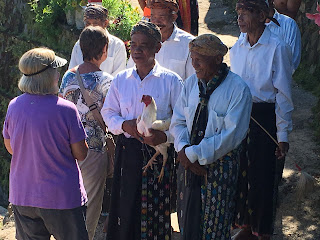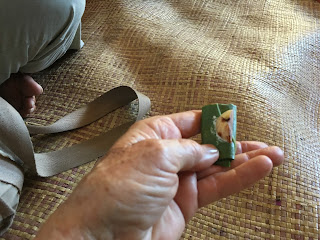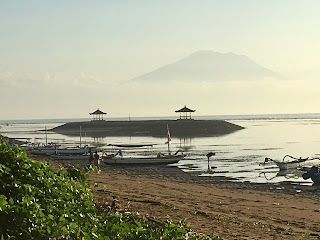Belitung
April, 2018
Part I Pre-Trip
Planning this trip was very lengthy, as the transit involved leaving Cape Breton, arriving in Ontario to see family and friends, a layover in Los Angelos to adjust to jet lag and meeting our good friend Maureen since 9th grade, my BFF, who would join us on this adventure.
We flew over the date line taking the great northern route. It was a comfortable flight with Eva Air.
We arrived in Jakarta, overnighted in an airport hotel and the next morning flew to Belitung, north of Jakarta to get rested and adjust our jetlag before joking OAT (Overseas Adventure Travel). We noticed great patches of deforested rainforest land growing what we later learned was palms. Click on link for more:
https://www.hrw.org/report/2019/09/23/when-we-lost-forest-we-lost-everything/oil-palm-plantations-and-rights-violations
Indonesia Background
Indonesia is a collection of 17,500 islands and an area of 735,358 square miles. It shares borders with Papua New Guinea, East Timor, Malaysia and Borneo. It lies between the Indian and Pacific Oceans.
Ethnicities and languages include the official Bahasa (modified form of Malay) as well as English, Dutch and local Javanese. Ethnicities are multiple, but the majority (40%) are Javanese and Sudanese (15.5%).
The majority of land is coastal but larger islands (Sumatra and Java) have mountain ranges. Some parts of the country are heavily populated and others consist of open countryside.
The population is 255,993,674. Religions are mainly Muslim 87% Christian 7% and Catholic 3%. The remainder are Hindu, Buddhist and others.
The cuisine is varied and sophisticated using many spices and primarily seafood or chicken. More about that later.
The earliest history goes back to the “Java Man” homo erectus, precursor to Homo sapiens over a million years ago. Historically, there were a succession of eras beginning with the Majapahit, the “Golden Age” more Hindu influence. Then followed in 1300 Sultanites and more Islam influence, bringing wealth through spice trading. The European influence began with the Portuguese and was followed by the Dutch who instituted the Dutch East India Company. They not only traded spices but opium and slaves as well. the King of Bali and other royalty were puppets in using their skilled craftsmen as slaves for the Dutch.
The Dutch instituted a cultivation system was set for indentured service until 1942 when Indonesia was occupied by the Japanese. Approximately 4 million Indonesians were killed in labour camps. They achieved Independence in 1945 two days after surrender of the Japanese.
Garuda is a legendary bird or bird-like creature in Hindu, Buddhist and Jain faith. It is also the name of a major Indonesian airlines. Garuda is described as the king of birds and a kite-like figure. He is shown either in zoomorphic form (giant bird with partially open wings) or an anthropomorphic form (man with wings and some bird features). Garuda is generally a protector with power to swiftly go anywhere, ever watchful and an enemy of the serpent. He is also known as Tarkshya and Vynateya.[8]
Garuda is a part of state insignia in India, Myanmar, Thailand, Cambodia and Indonesia. The Indonesian official coat of arms is centered on the Garuda. The national emblem of Indonesia is called Garuda Pancasila.
Belitung Island
We stayed 5 nights at Belitung Hotel & Klub in Tanjungpandan. The owner of our Hotel loaned me a book on shipwreck & history of Dutch Colonial Societad. We had a pleasant tour of the island by street taxi. We visited the the Museum and Zoo, E. Billiton car tour of Kaolin lakes, Chinese prayer centre, lunch at Fega, and a traditional Billiton wooded house.
seafoods & dishes and other interesting sites.
Lascar Pelangi School, movie & Book about Rainbow Troops by Andrea Hirata, Catherine saw the movie on Garuda flight.
The movie, set in the 1970s, opens on the first day of the year at a Muhammadiyah elementary school on Belitung. The school needs 10 students but is one short until near the end of the day, when a straggler fills out the ranks for their teachers, Muslimah and Harfan. Muslimah dubs the children "The Rainbow Troops" (sometimes translated as "The Rainbow Warriors") and the movie traces their development and relationships with the teachers.
Back to our hotel and pool, we were pampered by the hotel staff and introduced to Indonesian foods and practiced a few greetings and polite talk in Bahasa. “Selamat pagi, Apa kabar? Baik-baik!”
The next day we hired a dhow for a Five island tour, snorkel & seafood lunch. It was a very relaxing day and the rock formations were amazing. Peter enjoyed skippering the dhow under close supervision. The water was especially clear and the beaches clean.
There were sea turtles to sponsor, Orange Pillows" also known as "Chocolate Chip" starfish, and a very well built and maintained Dutch lighthouse. The water was crystal clear.
Turtle sanctuary and local currency.
OAT Java & Bali, Indonesia’s Mystical Islands
April 4-28, 2020
Part 2
Jakarta
We arrived at Jakarta airport decorated with thousands of gorgeous orchids of every colour. We were met by the our hotel chauffeur and met Ardi Firdaus, the Magnificent OAT Trip Leader and the rest of our travelling companions from 9 US states (AK, NY, CA, TX, TN, FL, MN, GA, OR) and yours truly from Canada.
And then there were ORCHIDS and beautiful WOODCARVING everywhere!
Jakarta was originally a trading port in the 4th century of the Kingdom of Sundra but the Dutch gained control over the Portuguese and named their colonial capitol Batavia. It is impossibly crowded and dirty. Today Jakarta is the capitol of Indonesia and the largest port but there are efforts underway to move the capitol as flooding is a major concern in Jakarta.
When Indonesia declared it's independence in 1945, Jakarta re-emerged as the symbol of the nation's freedom and diverse cultural heritage.
We were introduced to the superstition of beheading, bleeding Cobra during an evening orientation walk. Freshly killed cobra blood mixed with a milk or alcohol, is drunk and the skinned meat is threaded on a kebob stick and roasted over coals. The purpose of the drink is to enhance male sexual performance.
Later we learned about the “smelly” but delicious Dorian or jack fruit which we were advised to wear gloves to eat. It is known as the world's smelliest fruit. "A taste so rotten, a taste so sweet".
We were able to talk with a local minority leader in a predominately Muslim City. Surprisingly there were few issues at this time compared to the past. There have been tumultuous politics involving many countries in the past which are way beyond this blog.
We visited a Muslim Women’s Support group who with our translator, told us of great difficulty with women wanting to divorce according to their religion.
They entertained us later with refreshments and music.
We rode across on a “pull it yourself” ferry, a Tuk Tuk and for those who were brave motor scooters.
We were invited to a home dinner with a Muslim family who was a retail sales person and also very interested in teaching young people how to play the angklung. We were each given one and produced a nice tune.
On our usual walks or bus rides through neighbourhoods, we happened to come across three events, which typify an important Indonesian custom. Throughout life, Indonesians save for their cremation ceremony. When a person dies, the entire village honours the deceased by preparing a feast, which can last several days and which feeds the village, and sometimes takes place some time after the death.
A wealthy person will have a tower built and adorned, and then will be marched down the street and burned with great respect. We were welcomed to look around, ask questions and would have been welcomed to the feast, even though we did not know the deceased, all translated to English for us.
Here is one village where the women cook all day on one of the side streets we explored.

We had the experience of passing a huge group who were making preparations for a remembrance supper for one that had passed away about a year ago. The delay was important to plan so that close family could attend. There are always musicians to play, and the music chosen by the deceased.

We visited Sekar Rinonce, a foundation dedicated to conserving he art of batik. We were each assisted in making a design using wax and a special stylo. It was finished and mailed for us to pick up in Bali at the end of our trip. Peter’s textile is hanging in our cottage in the Barrachois.
Beeswax and special stylos are used to cover the design prior to dying. Batik will always have the design on both sides of the fabric after dying.
We travelled in a thee wheeled scooter to Fatabillah Square where we were approached by many students in a class trying to interview tourists in English.
We had a terrific lunch at Cafe Batavia, a 200 year old Art Deco and interesting photo collection of famous actors and leaders. It was grand!


Colonial era decor.
Yogyakarta “Jogya”
We took an early morning flight to Jogya below Mt Merapi. It is the Center of Javanese arts, handicrafts, dance and music.
On our way to Borobudur we stopped at a rest stop where we discovered a basket weaver on her veranda.. She welcomed us into her home, where we were shown a picture of she and her husband in their traditional wedding dress.
We visited the beautiful Borobudur Templ, the Saliendras's masterpiece, a massive pyramid of 6 tiers to the top. In true Buddhist style, "forlessness, the realm of nirvana, is dotted with 72 small latticework Stupas, each with a Buddha statue inside. UNESCO calls it the greatest Buddhist monuments in the world and ranks in importance as Angkor Wat, and a poignant epitaph to Java’s Buddhist Era.



We were entertained by dancers in a parade.
Prambanan is a UNESCO World Heritage Site and the largest Hindu temple complex in Indonesia. It was badly damaged by a major earthquake in the 16th century and still in various states of repair.
OAT is well known for spontaneous learning opportunities and we were introduced to a very important Election. There are registered voters and a special dye is used on a finger to signify that voting has occurred.
election
BALI
On our 8th day we flew from Jakarta to Candidasa, Bali. We were greeted by our local trip leader, Walika in traditional men's garment.
Bali is a Hindu enclave that stands alone in the middle of the rest of the largely Muslim Indonesia. It
has fostered deeply spiritual culture with arts, customs, and social rules, which is a mélange of different culture influences including Hinduism. Almost every street is adorned with "alters" which are filled with gifts, flowers, incense, candles, etc.
In Denpasar we visited a school of Balinese dance where we watched a performance and were given a shortened lesson. This was one of the highlights of the trip.

The next day, we toured picturesque rural villages along the slope of Mount Agung. One rest stop happened to be at a civet coffee farm. We are told it is quite delicious coffee, so I brought some home for friends.
High up in the mountains, we visited a Traditional Ikat Weaving which fosters employment for women.
Our next destination, Tirta Gangga, was the former summer residence of the Karang Asem royal family built around a sacred spring and four large pools dotted with statues, shines and pagodas. This is the present site where we enjoyed lunch with a view.
And Indonesia is the Yoga capitol of the world, so Catherine decided to take the opportunity. It is the place to learn yoga and receive a massage. My yoga experience was in a large covered gazebo next to the ocean and so relaxing to hear the waves and breathe!
We traveled to the Sudamala Purification Temple, where a Hindu priest conducted a purification ceremony using water from the temple`s holy spring. It is believed to provide spiritual cleansing. We all wore our bathing suits. Of course, we are all given sarongs each time we visit a temple.
And then we arrived in Ubud, a very popular tourist city, but sure to please everyone.
We visited the home of local mask maker whose masks are reknown worldwide.

He invited us to try chiseling the wood for masks and he and his family entertained us and allowed us to try on some of the many masks.
We toured Undiksha University and each of us were coupled with a student who gave us a first hand look at their education system and later went shopping at the market with a list, an OAT tradition.
Then we visited the Sacred Monkey Forest, home to over 600 macaque monkeys living among 14th century temples.
And each meal was a feast and such artistic presentations! We didn’t lose any weight on this tour! Some meals even came with entertainment!




And Local Beers!
Most restaurants had workshops demonstrating wood carving and gifts for purchase. This craftsman was carving about 30 panels for a Japanese temple. And notice the flexibility of those knees working for hours
 We went to the workshop of a puppet master, who performed a one person Balinese stick puppet show with his wife playing the xylophone.
We went to the workshop of a puppet master, who performed a one person Balinese stick puppet show with his wife playing the xylophone. An all day trip to Kintamani Volcano area was very interesting. There are gardens, lakes, volcanic ash fields and of course, a restaurant for lunch with a tower view.
We crossed Lake Batur by motorboat to the village of Trunyan, a desperately poor village very isolated by any other than boat travel.Trunyan is part of the Bali Aga ethinic group, known for their ancestral rituals. Contrary to Balinese tradition, these people do not practice cremation but display their dead in open graves, concealed by bamboo lattices and somewhat preserved by the roots of the fragrant taru menyan tree in their local cemetery. Ardi, our OAT Leader, wanted to show us the good, bad and ugly parts of his country and he did. The dead are surrounded by trinkets and personal belongings, and of course, it is accumulating with additions continuaously and no maintenance.
The next day we took a scenic ride to Jatiluwih in a 1970``s Jeep. Just like `Driving Miss Daisy` We were chauffeured in our convertible. Jatiluwih`s rice fields have been designated a UNESCO World Heritage Site because they exemplify a traditional Balinese community irrigation system known as subak. We enjoyed a walk among the dikes and rice paddies observing the activities from planting to harvesting.
Next, we drove around Lake Beratan, to see the rich vegetable production and markets and enjoyed lunch overlooking the Lake followed by a visit to a Botanical Garden before continuing to Lovina on Bali`s north shore lined with black, volcanic sand beaches and fishing villages.
The next day we were invited to a Community Lunch in a Balinese village in the rural hills outside Lovina.Citrus fruit orchards, cocoa and sugar plantations thrive in the north.
After a short visit and”tea” with the priest and his wife, we were escorted to the farming and crafting area, passing pig and cow stalls along a lovely mountain side trail.


Belitung
April, 2018
Part I Pre-Trip
Planning this trip was very lengthy, as the transit involved leaving Cape Breton, arriving in Ontario to see family and friends, a layover in Los Angelos to adjust to jet lag and meeting our good friend Maureen since 9th grade, my BFF, who would join us on this adventure.
We flew over the date line taking the great northern route. It was a comfortable flight with Eva Air.
We arrived in Jakarta, overnighted in an airport hotel and the next morning flew to Belitung, north of Jakarta to get rested and adjust our jetlag before joking OAT (Overseas Adventure Travel). We noticed great patches of deforested rainforest land growing what we later learned was palms. Click on link for more:
https://www.hrw.org/report/2019/09/23/when-we-lost-forest-we-lost-everything/oil-palm-plantations-and-rights-violations
Indonesia Background
Indonesia is a collection of 17,500 islands and an area of 735,358 square miles. It shares borders with Papua New Guinea, East Timor, Malaysia and Borneo. It lies between the Indian and Pacific Oceans.
Ethnicities and languages include the official Bahasa (modified form of Malay) as well as English, Dutch and local Javanese. Ethnicities are multiple, but the majority (40%) are Javanese and Sudanese (15.5%).
The majority of land is coastal but larger islands (Sumatra and Java) have mountain ranges. Some parts of the country are heavily populated and others consist of open countryside.
The population is 255,993,674. Religions are mainly Muslim 87% Christian 7% and Catholic 3%. The remainder are Hindu, Buddhist and others.
The cuisine is varied and sophisticated using many spices and primarily seafood or chicken. More about that later.
The earliest history goes back to the “Java Man” homo erectus, precursor to Homo sapiens over a million years ago. Historically, there were a succession of eras beginning with the Majapahit, the “Golden Age” more Hindu influence. Then followed in 1300 Sultanites and more Islam influence, bringing wealth through spice trading. The European influence began with the Portuguese and was followed by the Dutch who instituted the Dutch East India Company. They not only traded spices but opium and slaves as well. the King of Bali and other royalty were puppets in using their skilled craftsmen as slaves for the Dutch.
The Dutch instituted a cultivation system was set for indentured service until 1942 when Indonesia was occupied by the Japanese. Approximately 4 million Indonesians were killed in labour camps. They achieved Independence in 1945 two days after surrender of the Japanese.
Garuda is a legendary bird or bird-like creature in Hindu, Buddhist and Jain faith. It is also the name of a major Indonesian airlines. Garuda is described as the king of birds and a kite-like figure. He is shown either in zoomorphic form (giant bird with partially open wings) or an anthropomorphic form (man with wings and some bird features). Garuda is generally a protector with power to swiftly go anywhere, ever watchful and an enemy of the serpent. He is also known as Tarkshya and Vynateya.[8]
Garuda is a part of state insignia in India, Myanmar, Thailand, Cambodia and Indonesia. The Indonesian official coat of arms is centered on the Garuda. The national emblem of Indonesia is called Garuda Pancasila.
Belitung Island
We stayed 5 nights at Belitung Hotel & Klub in Tanjungpandan. The owner of our Hotel loaned me a book on shipwreck & history of Dutch Colonial Societad. We had a pleasant tour of the island by street taxi. We visited the the Museum and Zoo, E. Billiton car tour of Kaolin lakes, Chinese prayer centre, lunch at Fega, and a traditional Billiton wooded house.
seafoods & dishes and other interesting sites.
Lascar Pelangi School, movie & Book about Rainbow Troops by Andrea Hirata, Catherine saw the movie on Garuda flight.
The movie, set in the 1970s, opens on the first day of the year at a Muhammadiyah elementary school on Belitung. The school needs 10 students but is one short until near the end of the day, when a straggler fills out the ranks for their teachers, Muslimah and Harfan. Muslimah dubs the children "The Rainbow Troops" (sometimes translated as "The Rainbow Warriors") and the movie traces their development and relationships with the teachers.
Back to our hotel and pool, we were pampered by the hotel staff and introduced to Indonesian foods and practiced a few greetings and polite talk in Bahasa.
The next day we hired a dhow for a Five island tour, snorkel & seafood lunch. It was a very relaxing day and the rock formations were amazing. Peter enjoyed skippering the dhow under close supervision. The water was especially clear and the beaches clean.
There were sea turtles to sponsor, Orange Pillows" also known as "Chocolate Chip" starfish, and a very well built and maintained Dutch lighthouse. The water was crystal clear.
Turtle sanctuary and local currency.
OAT Java & Bali, Indonesia’s Mystical Islands
April 4-28, 2020
Part 2
Jakarta
We arrived at Jakarta airport decorated with thousands of gorgeous orchids of every colour. We were met by the our hotel chauffeur and met Ardi Firdaus, the Magnificent OAT Trip Leader and the rest of our travelling companions from 9 US states (AK, NY, CA, TX, TN, FL, MN, GA, OR) and yours truly from Canada.
And then there were ORCHIDS and beautiful WOODCARVING everywhere!
Jakarta was originally a trading port in the 4th century of the Kingdom of Sundra but the Dutch gained control over the Portuguese and named their colonial capitol Batavia. It is impossibly crowded and dirty. Today Jakarta is the capitol of Indonesia and the largest port but there are efforts underway to move the capitol as flooding is a major concern in Jakarta.
When Indonesia declared it's independence in 1945, Jakarta re-emerged as the symbol of the nation's freedom and diverse cultural heritage.
We were introduced to the superstition of beheading, bleeding Cobra during an evening orientation walk. Freshly killed cobra blood mixed with a milk or alcohol, is drunk and the skinned meat is threaded on a kebob stick and roasted over coals. The purpose of the drink is to enhance male sexual performance.
Later we learned about the “smelly” but delicious Dorian or jack fruit which we were advised to wear gloves to eat. It is known as the world's smelliest fruit. "A taste so rotten, a taste so sweet".
We were able to talk with a local minority leader in a predominately Muslim City. Surprisingly there were few issues at this time compared to the past. There have been tumultuous politics involving many countries in the past which are way beyond this blog.
We visited a Muslim Women’s Support group who with our translator, told us of great difficulty with women wanting to divorce according to their religion.
They entertained us later with refreshments and music.
We rode across on a “pull it yourself” ferry, a Tuk Tuk and for those who were brave motor scooters.
We were invited to a home dinner with a Muslim family who was a retail sales person and also very interested in teaching young people how to play the angklung. We were each given one and produced a nice tune.
On our usual walks or bus rides through neighbourhoods, we happened to come across three events, which typify an important Indonesian custom. Throughout life, Indonesians save for their cremation ceremony. When a person dies, the entire village honours the deceased by preparing a feast, which can last several days and which feeds the village, and sometimes takes place some time after the death.
A wealthy person will have a tower built and adorned, and then will be marched down the street and burned with great respect. We were welcomed to look around, ask questions and would have been welcomed to the feast, even though we did not know the deceased, all translated to English for us.
Here is one village where the women cook all day on one of the side streets we explored.

We had the experience of passing a huge group who were making preparations for a remembrance supper for one that had passed away about a year ago. The delay was important to plan so that close family could attend. There are always musicians to play, and the music chosen by the deceased.

We visited Sekar Rinonce, a foundation dedicated to conserving he art of batik. We were each assisted in making a design using wax and a special stylo. It was finished and mailed for us to pick up in Bali at the end of our trip. Peter’s textile is hanging in our cottage in the Barrachois.
Beeswax and special stylos are used to cover the design prior to dying. Batik will always have the design on both sides of the fabric after dying.
We travelled in a thee wheeled scooter to Fatabillah Square where we were approached by many students in a class trying to interview tourists in English.
We had a terrific lunch at Cafe Batavia, a 200 year old Art Deco and interesting photo collection of famous actors and leaders. It was grand!


Colonial era decor.
Yogyakarta “Jogya”
We took an early morning flight to Jogya below Mt Merapi. It is the Center of Javanese arts, handicrafts, dance and music.
On our way to Borobudur we stopped at a rest stop where we discovered a basket weaver on her veranda.. She welcomed us into her home, where we were shown a picture of she and her husband in their traditional wedding dress.
We visited the beautiful Borobudur Templ, the Saliendras's masterpiece, a massive pyramid of 6 tiers to the top. In true Buddhist style, "forlessness, the realm of nirvana, is dotted with 72 small latticework Stupas, each with a Buddha statue inside. UNESCO calls it the greatest Buddhist monuments in the world and ranks in importance as Angkor Wat, and a poignant epitaph to Java’s Buddhist Era.



We were entertained by dancers in a parade.
Prambanan is a UNESCO World Heritage Site and the largest Hindu temple complex in Indonesia. It was badly damaged by a major earthquake in the 16th century and still in various states of repair.
OAT is well known for spontaneous learning opportunities and we were introduced to a very important Election. There are registered voters and a special dye is used on a finger to signify that voting has occurred.
election
BALI
On our 8th day we flew from Jakarta to Candidasa, Bali. We were greeted by our local trip leader, Walika in traditional men's garment.
Bali is a Hindu enclave that stands alone in the middle of the rest of the largely Muslim Indonesia. It
has fostered deeply spiritual culture with arts, customs, and social rules, which is a mélange of different culture influences including Hinduism. Almost every street is adorned with "alters" which are filled with gifts, flowers, incense, candles, etc.
In Denpasar we visited a school of Balinese dance where we watched a performance and were given a shortened lesson. This was one of the highlights of the trip.

The next day, we toured picturesque rural villages along the slope of
Mount Agung. One rest stop happened to be at a civet coffee farm. We are told it is quite delicious coffee, so I brought some home for friends.
High up in the mountains, we visited a Traditional Ikat Weaving which fosters employment for women.
Our next destination, Tirta Gangga, was the former summer residence of the Karang Asem royal family built around a sacred spring and four large pools dotted with statues, shines and pagodas. This is the present site where we enjoyed lunch with a view.
X
And Indonesia is the Yoga capitol of the world, so Catherine decided to take the opportunity. It is the place to learn yoga and receive a massage. My yoga experience was in a large covered gazebo next to the ocean and so relaxing to hear the waves and breathe!
We traveled to the Sudamala Purification Temple, where a Hindu priest conducted a purification ceremony using water from the temple`s holy spring. It is believed to provide spiritual cleansing. We all wore our bathing suits.
And then we arrived in Ubud, a very popular tourist city, but sure to please everyone.
We visited the home of local mask maker whose masks are reknown worldwide.

He invited us to try chiseling the wood for masks and he and his family entertained us and allowed us to try on some of the many masks.
We toured Undiksha University and each of us were coupled with a student who gave us a first hand look at their education system and later went shopping at the market with a list, an OAT tradition.
Then we visited the Sacred Monkey Forest, home to over 600 macaque monkeys living among 14th century temples.
And each meal was a feast and such artistic presentations! We didn’t lose any weight on this tour! Some meals even came with entertainment!




And Local Beers!
Most restaurants had workshops demonstrating wood carving and gifts for purchase. This craftsman was carving about 30 panels for a Japanese temple. And notice the flexibility of those knees working for hours
 We went to the workshop of a puppet master, who performed a one person Balinese stick puppet show with his wife playing the xylophone.
We went to the workshop of a puppet master, who performed a one person Balinese stick puppet show with his wife playing the xylophone.
An all day trip to Kintamani Volcano area was very interesting. There are gardens, lakes, volcanic ash fields and of course, a restaurant for lunch with a tower view.
We crossed Lake Batur by motorboat to the village of Trunyan, a desperately poor village very isolated by any other than boat travel.Trunyan is part of the Bali Aga ethinic group, known for their ancestral rituals. Contrary to Balinese tradition, these people do not practice cremation but display their dead in open graves, concealed by bamboo lattices and somewhat preserved by the roots of the fragrant taru menyan tree in their local cemetery. Ardi, our OAT Leader, wanted to show us the good, bad and ugly parts of his country and he did. The dead are surrounded by trinkets and personal belongings, and of course, it is accumulating with additions continuaously and no maintenance.
The next day we took a scenic ride to Jatiluwih in a 1970``s Jeep. Just like `Driving Miss Daisy` We were chauffeured in our convertible. Jatiluwih`s rice fields have been designated a UNESCO World Heritage Site because they exemplify a traditional Balinese community irrigation system known as subak. We enjoyed a walk among the dikes and rice paddies observing the activities from planting to harvesting.
Next, we drove around Lake Beratan, to see the rich vegetable production and markets and enjoyed lunch overlooking the Lake followed by a visit to a Botanical Garden before continuing to Lovina on Bali`s north shore lined with black, volcanic sand beaches and fishing villages.
The next day we were invited to a Community Lunch in a Balinese village in the rural hills outside Lovina.Citrus fruit orchards, cocoa and sugar plantations thrive in the north.
1. Peter playing music at the priest’s home
After a short visit and”tea” with the priest and his wife, we were escorted to the farming and crafting area, passing pig and cow stalls along a lovely mountain side trail.
A

We noted an elderly man who was climbing a palm tree to collect the sap for making wine and a whiskey which we were able to sample after our meal.
Arak Bali is made from distilled sap of sugar palm or the glutinous rice. Arak Bali is known because of its distinct taste and it also acts as a warmer.
We enjoyed presenting presents (an inflatable globe) to children and showed them where we all live.
Basket making can be done with closed eyes by them but they patiently helped us to do a bit of braiding. There were bamboo panels, bags, blouses and many other gifts for purchase.
We enjoyed a cooking class followed by the delicious dinner complete with dessert.
On our last night in Bali we booked a special performance, and we were not disappointed.
Kecak known in Indonesian as tari kecak, is a form of Balinese hindu dance and music drama ... Also known as the Ramayana monkey chant, the dance is performed by a circle of as many as 150 performers wearing checked cloths around ... The most popular destination for kechak dance performances is Uluwatu.*****
The next morning we visited Kusamba, a coastal village known for its black sand beach. We
visited a family operated sea salt reclamation on the ocean, and very labour intensive.
Our last expedition was to Sanur to visit Uluwatu Cliffside Temple.in Pura Luhur Uluwati, or Temple above the Headstone, a Balinese sea temple. It’s origins date back to the tenth century perched on a cliff 330 fleet above the water. There are plenty of aggressive macaque monkeys and Hindu Ganesha statues.
Additionally the “selfie Chinese” were in abundance.
Creative lighting for a coffee shop

Kitamura Beach & Sunsets

Black pearls
Our terrific trip leaders were in their traditional dress for our Farewell Dinner.
We learned so much here and this blog will refresh our memories for many years to come
KOMODO ISLAND
Part 3
Land of Dragons
We flew to Flores, Labuan Bajo and met our local Trip Leader, Sylester. After lunch, and a relaxing swim, we met for a walk around Bukit Cinta (Love Hill) with a panoramic view of the sunset.
The next day we had an all day exploration of Komodo Island, a UNESCO World Heritage Site. Like many countries, Komodo was first settled as a penal exile colony but today, it is occupied by families of fishermen. It is best known for the legendary ten-foot monitor lizards "dragons" named by the Dutch.
A local ranger greeted us then lead us on a exploration of the island's flora and fauna. We walked, guarded by other guides with sticks, quietly to not disturb the lizards. To learn more about the Komodo dragon click this link: https://www.nationalgeographic.com/animals/reptiles/k/komodo-dragon/).
We discovered a pink sand beach made by foraminifera (livingmarine protozoa which turns the sand red, which mixed with the normal white sand). Snorkeling was incredible but the current was strong. Sadly, the amount of plastic waste all along the waterfront detracted from what could have been a lovely picnic. We began a beach pickup project and carried the trash back to our boat for proper disposal. Sadly, a few days later, it was still sitting on the dock. We complained, and it was attended to (somehow?).
We spent the day exploring the island of Flores and visited Cecer Village, where the Manggarai speak their own dialect and the village elders work hard to preserve their culture.
We were instructed to choose a leader to receive a gift from the. Chief. Donna graciously accepted the chicken.
We were brought into the community it’s hall and offered a packet of betel leaf and nut to chew and enjoy.
We listened to their blessing and learned the traditional rolls of the men and women. They were interested in what at each one of us did as well. Click on the link to learn more of this herb and it’s customary use.
https://www.ncbi.nlm.nih.gov/pmc/articles/PMC3892533/
Peter admired the beautiful wood purposed for building.
And then the music, dancing and “masculinity trials” began!
We participated in introduced to coffee grinding.


Local Coffee Production using traditional tools and always along with music. 
Babysitters and cute kids.
We witnessed Caci dancing, a sport in which masked men wield whips in stylized combat that is meant to symbolize the unity of men and women in creation.
We were invited to crack nuts using their traditional tools.
2. Ladies doing stick dancing
3. Woman’s stick
The next day, we again motored to Rinca Island, part of the Komodo National Park on a traditional fishing boat. Rinca is smaller and the best locale for witnessing the Komodo dragons in their natural habitat. And we saw many and close up.
The next morning, Maureen and the rest of the OAT group flew back to Denpasar and their flight back to Los Angelos. Peter and I had to make a short trip to to renew our Indonesian visa as penalties for overstaying were hefty. On returning we flew back to Labuan Bajo to rest a couple of days before beginning our Live Aboard SCUBA Dive Adventure aboard Duyung Baru (see Nov, 2020 blog for amazing dive experience.
Our last night in Labuan Bajo was a special trip at the ocean side market for local favourites like grilled squid and fried shrimp. Ardi demonstrated the way the locals eat the shrimp heads.
A

We noted an elderly man who was climbing a palm tree to collect the sap for making wine and a whiskey which we were able to sample after our meal.

Arak Bali is made from distilled sap of sugar palm or the glutinous rice. Arak Bali is known because of its distinct taste and it also acts as a warmer.
We enjoyed presenting presents (an inflatable globe) to children and showed them where we all live.
Basket making can be done with closed eyes by them but they patiently helped us to do a bit of braiding. There were bamboo panels, bags, blouses and many other gifts for purchase.
We enjoyed a cooking class followed by the delicious dinner complete with dessert.
On our last night in Bali we booked a special performance, and we were not disappointed.
Kecak known in Indonesian as tari kecak, is a form of Balinese hindu dance and music drama ... Also known as the Ramayana monkey chant, the dance is performed by a circle of as many as 150 performers wearing checked cloths around ... The most popular destination for kechak dance performances is Uluwatu.*****
The next morning we visited Kusamba, a coastal village known for its black sand beach. We
visited a family operated sea salt reclamation on the ocean, and very labour intensive.
Our last expedition was to Sanur to visit Uluwatu Cliffside Temple.in Pura Luhur Uluwati, or Temple above the Headstone, a Balinese sea temple. It’s origins date back to the tenth century perched on a cliff 330 fleet above the water. There are plenty of aggressive macaque monkeys and Hindu Ganesha statues.
Additionally the “selfie Chinese” were in abundance.
Creative lighting for a coffee shop

Kitamura Beach & Sunsets

Black pearls
Our terrific trip leaders were in their traditional dress for our Farewell Dinner.
We learned so much here and this blog will refresh our memories for many years to come
KOMODO ISLAND
Part 3
Land of Dragons
We flew to Flores, Labuan Bajo and met our local Trip Leader, Sylester. After lunch, and a relaxing swim, we met for a walk around Bukit Cinta (Love Hill) with a panoramic view of the sunset.
The next day we had an all day exploration of Komodo Island, a UNESCO World Heritage Site. Like many countries, Komodo was first settled as a penal exile colony but today, it is occupied by families of fishermen. It is best known for the legendary ten-foot monitor lizards "dragons" named by the Dutch.
A local ranger greeted us then lead us on a exploration of the island's flora and fauna. We walked, guarded by other guides with sticks, quietly to not disturb the lizards. To learn more about the Komodo dragon click this link: https://www.nationalgeographic.com/animals/reptiles/k/komodo-dragon/).
We discovered a pink sand beach made by foraminifera (livingmarine protozoa which turns the sand red, which mixed with the normal white sand). Snorkeling was incredible but the current was strong. Sadly, the amount of plastic waste all along the waterfront detracted from what could have been a lovely picnic. We began a beach pickup project and carried the trash back to our boat for proper disposal. Sadly, a few days later, it was still sitting on the dock. We complained, and it was attended to (somehow?).
We spent the day exploring the island of Flores and visited Cecer Village, where the Manggarai speak their own dialect and the village elders work hard to preserve their culture.
We were instructed to choose a leader to receive a gift from the. Chief. Donna graciously accepted the chicken.
We were brought into the community it’s hall and offered a packet of betel leaf and nut to chew and enjoy.
We listened to their blessing and learned the traditional rolls of the men and women. They were interested in what at each one of us did as well. Click on the link to learn more of this herb and it’s customary use.
Peter admired the beautiful wood purposed for building.
And then the music, dancing and “masculinity trials” began!
We participated in introduced to coffee grinding.


Local Coffee Production using traditional tools and always along with music. 
Babysitters and cute kids.
We witnessed Caci dancing, a sport in which masked men wield whips in stylized combat that is meant to symbolize the unity of men and women in creation.
Ladies doing stick
Our last night in Labuan Bajo was a special trip at the ocean side market for local favourites like grilled squid and fried shrimp. Ardi demonstrated the way the locals eat the shrimp heads.

Written years later with a frustrating, uncooperative program
Catherine & Peter
Aboard S/V Charlotte D
Antigua & Barbuda






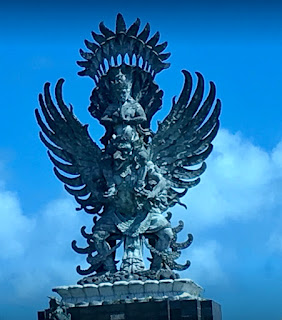









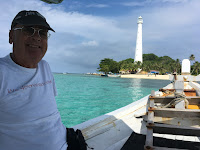

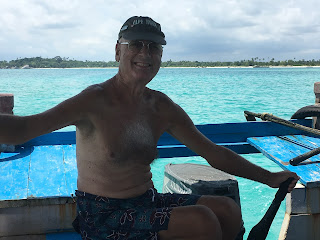










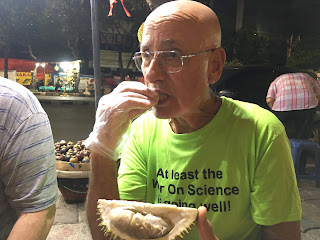

















 Colonial era decor.
Colonial era decor.






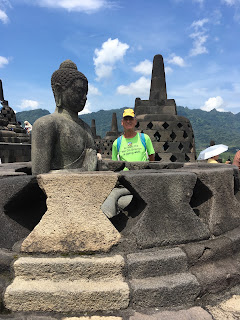


 We were entertained by dancers in a parade.
We were entertained by dancers in a parade.


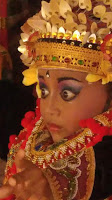


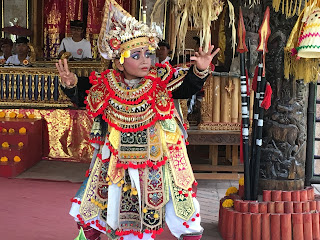






















 We went to the workshop of a puppet master, who performed a one person Balinese stick puppet show with his wife playing the xylophone.
We went to the workshop of a puppet master, who performed a one person Balinese stick puppet show with his wife playing the xylophone. 


















































 Colonial era decor.
Colonial era decor.









 We were entertained by dancers in a parade.
We were entertained by dancers in a parade.




























 We went to the workshop of a puppet master, who performed a one person Balinese stick puppet show with his wife playing the xylophone.
We went to the workshop of a puppet master, who performed a one person Balinese stick puppet show with his wife playing the xylophone. 


















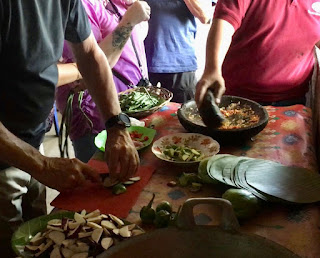

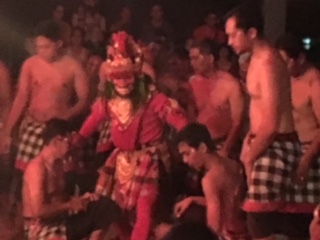












 Kitamura Beach & Sunsets
Kitamura Beach & Sunsets Black pearls
Black pearls 



